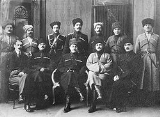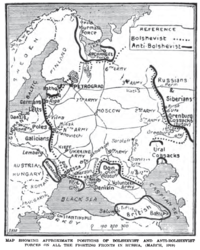
Mountainous Republic of the Northern Caucasus
Encyclopedia
The Mountainous Republic of the Northern Caucasus (MRNC; also known as the Mountain Republic or the Republic of the Mountaineers) (1917–1920) was a short-lived state situated in the Northern Caucasus. It included most of the territory of the former Terek Oblast and Dagestan Oblast of the Russian Empire
, which now form the republics of Chechnya
, Ingushetia
, North Ossetia-Alania
, Kabardino-Balkaria
, Dagestan
and part of Stavropol Krai
of the Russian Federation.
The total land area of the MRNC was about 70000 square kilometres (27,027.2 sq mi), with a population of about 1 million. Its capital was initially at Vladikavkaz
, then Nazran
, and finally Temir-Khan-Shura
.
. The "Nizam" of Imam Shamil
(the Constitution of Shamil of 1847) was adopted on 5 August 1917 by the "Central Committee of the Northern Caucasus". The republic was officially established on 11 May 1918, after the collapse of the Russian Tsarist empire in the Russian revolution of 1917
, when the Government of the MRNC was established.
The main founders of the MRNC included Said Shamil (grandson of Imam Shamil
, who in 1924 would become a founder and leader of the "Committee of Independence of the Caucasus" in Germany
), Prime Minister
Tapa Tchermoeff
, Sheikh
Ali-Khaji Akusha and Haidar Bamat. The Republic's capital was Temir-Khan-Shura.
The Mountainous Republic was de jure
recognized by the Ottoman Empire
, Germany
, Azerbaijan Democratic Republic
, Democratic Republic of Georgia
and the Kuban People's Republic
.
 During the Russian Civil War
During the Russian Civil War
, the Mountaineers were engaged in fierce clashes against the invading White
troops of General Anton Denikin's Volunteer Army
. The fighting ended in January 1920, when Denikin's army was completely defeated by the XI Red Army. The advancing Red Army was at first greeted with red flags in the villages of the Northern Caucasus, but the promises of autonomous rule made by the Bolsheviks went unrealized.
In June 1920, the MRNC was occupied by the Red Army of Bolshevik Russia and the Government of the republic was forced to leave the Caucasus. In January 1921 the Soviet Mountain Republic
of the Russian SFSR was established.
Russian Empire
The Russian Empire was a state that existed from 1721 until the Russian Revolution of 1917. It was the successor to the Tsardom of Russia and the predecessor of the Soviet Union...
, which now form the republics of Chechnya
Chechnya
The Chechen Republic , commonly referred to as Chechnya , also spelled Chechnia or Chechenia, sometimes referred to as Ichkeria , is a federal subject of Russia . It is located in the southeastern part of Europe in the Northern Caucasus mountains. The capital of the republic is the city of Grozny...
, Ingushetia
Ingushetia
The Republic of Ingushetia is a federal subject of Russia , located in the North Caucasus region with its capital at Magas. In terms of area, the republic is the smallest of Russia's federal subjects except for the two federal cities, Moscow and Saint Petersburg...
, North Ossetia-Alania
North Ossetia-Alania
The Republic of North Ossetia–Alania is a federal subject of Russia . Its population according to the 2010 Census was 712,877.-Name:...
, Kabardino-Balkaria
Kabardino-Balkaria
The Kabardino-Balkar Republic , or Kabardino-Balkaria , is a federal subject of Russia located in the North Caucasus. Population: -Geography:The republic is situated in the North Caucasus mountains, with plains in the northern part....
, Dagestan
Dagestan
The Republic of Dagestan is a federal subject of Russia, located in the North Caucasus region. Its capital and the largest city is Makhachkala, located at the center of Dagestan on the Caspian Sea...
and part of Stavropol Krai
Stavropol Krai
Stavropol Krai is a federal subject of Russia . Its administrative center is the city of Stavropol. Population: -Geography:Stavropol Krai encompasses the central part of the Fore-Caucasus and most of the northern slopes of Caucasus Major...
of the Russian Federation.
The total land area of the MRNC was about 70000 square kilometres (27,027.2 sq mi), with a population of about 1 million. Its capital was initially at Vladikavkaz
Vladikavkaz
-Notable structures:In Vladikavkaz, there is a guyed TV mast, tall, built in 1961, which has six crossbars with gangways in two levels running from the mast structure to the guys.-Twin towns/sister cities:...
, then Nazran
Nazran
Nazran is a town in the Republic of Ingushetia, Russia. It served as the republic's capital in 1991–2000, until the town of Magas was specially built as the new capital. Nazran is the largest city of the republic: -General:...
, and finally Temir-Khan-Shura
Buynaksk
Buynaksk is a town in the Republic of Dagestan, Russia, located at the foothills of the Greater Caucasus on the Shura-Ozen River, southwest of the republic's capital Makhachkala. Population: 40,000 ....
.
History
The "Union of the Peoples of the Northern Caucasus" was created in March 1917, and an Executive Committee of the Union was elected. The Chairman of the Executive Committee was one of the leaders of the National‐Liberation movement of the Peoples of the Northern Caucasus, Tapa TchermoeffTapa Tchermoeff
Abdul "Tapa" Midgit Bey Ortsa Tchermoeff was the first and last Prime Minister of the Mountainous Republic of the Northern Caucasus. He was in office from May 11, 1918 until the entire government was forced into exile by the advancing Bolsheviks in 1921...
. The "Nizam" of Imam Shamil
Imam Shamil
Imam Shamil also spelled Shamyl, Schamil, Schamyl or Shameel was an Avar political and religious leader of the Muslim tribes of the Northern Caucasus...
(the Constitution of Shamil of 1847) was adopted on 5 August 1917 by the "Central Committee of the Northern Caucasus". The republic was officially established on 11 May 1918, after the collapse of the Russian Tsarist empire in the Russian revolution of 1917
Russian Revolution of 1917
The Russian Revolution is the collective term for a series of revolutions in Russia in 1917, which destroyed the Tsarist autocracy and led to the creation of the Soviet Union. The Tsar was deposed and replaced by a provisional government in the first revolution of February 1917...
, when the Government of the MRNC was established.
The main founders of the MRNC included Said Shamil (grandson of Imam Shamil
Imam Shamil
Imam Shamil also spelled Shamyl, Schamil, Schamyl or Shameel was an Avar political and religious leader of the Muslim tribes of the Northern Caucasus...
, who in 1924 would become a founder and leader of the "Committee of Independence of the Caucasus" in Germany
Germany
Germany , officially the Federal Republic of Germany , is a federal parliamentary republic in Europe. The country consists of 16 states while the capital and largest city is Berlin. Germany covers an area of 357,021 km2 and has a largely temperate seasonal climate...
), Prime Minister
Prime minister
A prime minister is the most senior minister of cabinet in the executive branch of government in a parliamentary system. In many systems, the prime minister selects and may dismiss other members of the cabinet, and allocates posts to members within the government. In most systems, the prime...
Tapa Tchermoeff
Tapa Tchermoeff
Abdul "Tapa" Midgit Bey Ortsa Tchermoeff was the first and last Prime Minister of the Mountainous Republic of the Northern Caucasus. He was in office from May 11, 1918 until the entire government was forced into exile by the advancing Bolsheviks in 1921...
, Sheikh
Sheikh
Not to be confused with sikhSheikh — also spelled Sheik or Shaikh, or transliterated as Shaykh — is an honorific in the Arabic language that literally means "elder" and carries the meaning "leader and/or governor"...
Ali-Khaji Akusha and Haidar Bamat. The Republic's capital was Temir-Khan-Shura.
The Mountainous Republic was de jure
De jure
De jure is an expression that means "concerning law", as contrasted with de facto, which means "concerning fact".De jure = 'Legally', De facto = 'In fact'....
recognized by the Ottoman Empire
Ottoman Empire
The Ottoman EmpireIt was usually referred to as the "Ottoman Empire", the "Turkish Empire", the "Ottoman Caliphate" or more commonly "Turkey" by its contemporaries...
, Germany
Germany
Germany , officially the Federal Republic of Germany , is a federal parliamentary republic in Europe. The country consists of 16 states while the capital and largest city is Berlin. Germany covers an area of 357,021 km2 and has a largely temperate seasonal climate...
, Azerbaijan Democratic Republic
Azerbaijan Democratic Republic
The Azerbaijan Democratic Republic was the first successful attempt to establish a democratic and secular republic in the Muslim world . The ADR was founded on May 28, 1918 after the collapse of the Russian Empire that began with the Russian Revolution of 1917 by Azerbaijani National Council in...
, Democratic Republic of Georgia
Democratic Republic of Georgia
The Democratic Republic of Georgia , 1918–1921, was the first modern establishment of a Republic of Georgia.The DRG was created after the collapse of the Russian Empire that began with the Russian Revolution of 1917...
and the Kuban People's Republic
Kuban People's Republic
The Kuban People's Republic was an anti-Bolshevik state that comprised the territory of the Kuban in the modern-day Russian Federation during the Russian Civil War....
.

Russian Civil War
The Russian Civil War was a multi-party war that occurred within the former Russian Empire after the Russian provisional government collapsed to the Soviets, under the domination of the Bolshevik party. Soviet forces first assumed power in Petrograd The Russian Civil War (1917–1923) was a...
, the Mountaineers were engaged in fierce clashes against the invading White
White movement
The White movement and its military arm the White Army - known as the White Guard or the Whites - was a loose confederation of Anti-Communist forces.The movement comprised one of the politico-military Russian forces who fought...
troops of General Anton Denikin's Volunteer Army
Volunteer Army
The Volunteer Army was an anti-Bolshevik army in South Russia during the Russian Civil War of 1918-1920....
. The fighting ended in January 1920, when Denikin's army was completely defeated by the XI Red Army. The advancing Red Army was at first greeted with red flags in the villages of the Northern Caucasus, but the promises of autonomous rule made by the Bolsheviks went unrealized.
In June 1920, the MRNC was occupied by the Red Army of Bolshevik Russia and the Government of the republic was forced to leave the Caucasus. In January 1921 the Soviet Mountain Republic
Soviet Mountain Republic
Mountain Autonomous Soviet Socialist Republic or Mountain ASSR was a short-lived autonomous republic within the Russian SFSR in the Northern Caucasus that existed from January 20, 1921 to July 7, 1924....
of the Russian SFSR was established.

